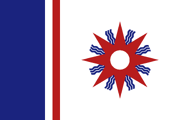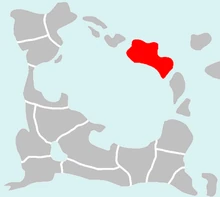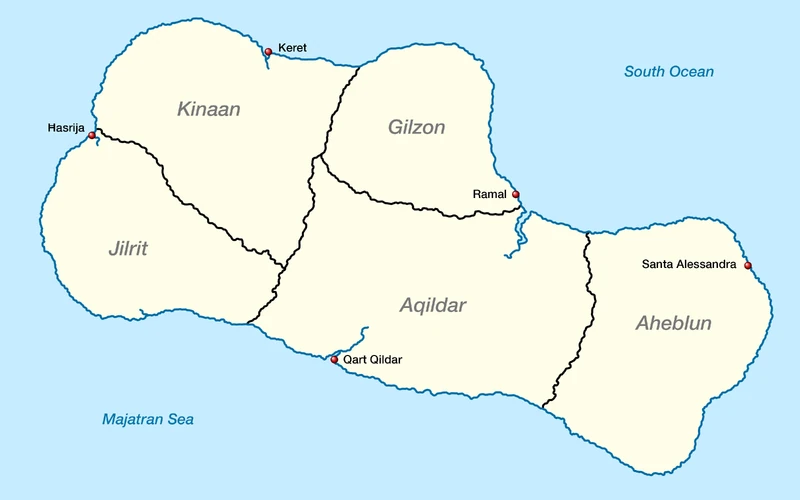Motto | |||||
| Anthem | "Arise O Cildania" | ||||
| Capital (and largest city) |
Qart Qildar | ||||
| Language official |
Gziri | ||||
| others | Hebilean | ||||
| Religion | Apostolic Church of the Isles | ||||
| Demonym | Cildanian | ||||
| Government | Unitary parliamentary constitutional monarchy | ||||
| Grand Prince | Adherbal | ||||
| Prime Minister | Claire Tortell | ||||
| Legislature | Council of Deputies | ||||
| Area | 895.800 km² | ||||
| Population | 30,423,498 (4743 estimate) | ||||
| GDP Total: |
| ||||
| per capita | |||||
| Established | 5234 (current Principality) 2092 (first Republic) | ||||
| Currency | Cildanian Cildar (CDC, | ||||
| Time Zone | GMT +1 | ||||
| summer | GMT +2 | ||||
| Drives on the | Right | ||||
| Calling Code | +37 | ||||
| Internet TLD | .cd | ||||
| Organizations | World Congress | ||||
Cildania (Gziri: Kildanja), officially Grand Principality of Cildania (Gziri: Gran Prinċipat ta’ Kildanja), is an island country in Majatra. Situated in the northern Majatran Sea, it is located north-west of Badara and south-east of Selucia. The island of Sint Pietereiland, a region of Saridan is located to the east of Cildania.
The recorded history of the island dates back to approximately the eighth century BCE. During this period, the Qedarite Migrations brought large numbers of Qedarite peoples to the island.
Qart Qildar is the capital, major economic and cultural center of the nation and has been for several decades. Qart Ramesh and several other cities play vital roles in the nations cultural and economic importance.
Etymology[]
In the Gziri language, the name of the country is Kildanja. The name derives from the dead Qildari language and the ancient city of Qart Qildar, which was the centre of the Qedarite Empire. In Qildari, the country was known as Qildar. The common Luthorian name for the country "Cildania" is a Luthorianisation of the Qildari name.
History[]
Ancient Cildania (700 BCE-400 BCE)[]
Qedarites were organized into independent city-states, which often competed and cooperated among themselves, as one city after another came to establish political and economic hegemony over the entire island. At the time, Qedarite merchant fleets were among the largest and most prosperous in the world. In order to provide supply lines for their merchant fleets, to maintain Qedarite monopoly over an area's resources, or to conduct trade, the Qedarites established numerous colonial cities along the coasts of the Majatran Sea, competing with Selucian and Kalopian city-states; many of the Qedarite colonies are now important cities.
Birth of Yeudism (~500 BCE)[]
Cildania is the traditional birthplace of the religion of Yeudism, which emerged sometime around 500 BCE. Despite this, Yeudi followers largely left Cildania soon after, while the remainder were persecuted. Nevertheless, there remains a continuous Yeudi presence in Cildania dating from this period.
Ancient Qedarite Hegemony (400 BCE-800 AD)[]
The Qedarite city-states, though in frequent conflict, generally recognized the hegemony of a single city-state as the political, economic, and religious centre of the island. The dominant city exploited its power chiefly by requesting tributes, though such tributes were generally of a symbolic or gifting nature.
The Qart Qildar-Ramal War (451-437 BCE) radically altered the political dynamic of the island, when the city of Qildar challenged the hegemony of Ramal. The crushing defeat of Ramal resulted in Qildar becoming the ruling city in the island through force and coercion. Qildar established its power by sending garrisons to the cities that had fallen into its sphere, and the continual skirmishes with Afejri tribes in the east brought the numerous Qedarite cities and colonies into the Qedarite sphere. The Qedarite Empire would go on to establish dominance over the entire Majatran Sea, and was at its zenith the largest empire on the continent, until it eventually collapsed around 22 CE with the Jelbo-Tukaric invasions. Qildar remained the most culturally, economically, and politically important city on the island, a status which resulted it has retained for centuries, leading to the modern name of the nation (Qildar/Cildania) being derived from it. However, with the fall of the Qedarite Empire, the island was left divided for the next 1000 years.
Early Medieval Cildania (840-1394)[]
In 840, Hosianism was introduced from Barmenia. The majority of the Cildanian states were quick to adopt it, as well as the medieval feudal structure. This marked the beginning of the medieval period in Cildania, from many of the crowns, titles and noble families of today originated. In the 14th century, Cildania was locked constant conflict with Selucia. During the Qildar-Selucian War (1382-1394), many of Cildania's disparate city-states, fiefdoms, and theocracies coordinated in defeating the Selucian invasion of Cildania. This success led to a new found sense of national identity.
Council period (1394-1847)[]
Following the Qildar-Selucian War, a grand council was called by the Patriarch of the Apostolic Church of the Isles Theophanes II to be held at the monastery of San Origen in Akildar. The Council, known as the "Council of San Origen" was composed of: the five princes of each of Cildania's principalities, Aqildar, Aheblun, Gilzon, Jilrit, Kinaan; the Bishops of Cildania, and the Mayors of the Free Cities. Resolving to unify in the face of external threats, a permanent council was formed, which would come to be known as the Council of Princes. The Council of Princes resembled a federal council government, and consisted of the Patriarch, the Five Princes, a representative from the Free Cities, and was chaired by the Patriarch. Decisions were to be made democratically, with the Patriarch having two votes in Council as he represented both the Church and the people. The Council period of Cildania lasted for around 400 years and was one of the most peaceful periods in Cildanian history.
Divine Kingdom period (1847-19XX)[]
In 1847, Prince Gildas Kilian of Aqildar dissolved the Council of Princes and declared himself Divine King of Cildania (HaMelek HaʾIilohi shel Qildar), with the Patriarch's consent and the support of the Princes of Kinaan, Gilzon and Jilrit, and the representative of the Free Cities. Prince Jugurtha of Aheblun, however, did not support Gildas, and disputed his authority and that of the Patriarch. Tensions culminated in Jugurtha declared himself Hebileean Patriarch-Prince, consolidating both roles, and seceding from the Divine Kingdom. Prince Jugurtha raised an army to assert his independence, and the thirty year War of Unification (1847-1878) ensued. The war was ended when Gildas slayed Jugurtha on the battlefield, unifying Cildania under his rule. In a gesture of reconciliation, the Divine King allowed Jugurtha's descendants to live, though the Divine King retained the title of Prince of Aheblun.
The Divine Kingdom was as a caesaropapist state, whereby the Apostolic Department of Cildania (precursor to the modern Apostolic Church of the Isles) was entirely subordinate to the Divine King. The Council of the Princes was reestablished in 1895 to curb the power of the Divine King. In 1896, the Council of Princes transformed the monarchy from a hereditary one to an elective one, with the Council of Princes serving as candidates and electors. In 1901, the Council of Princes convened Cildania's first parliament. The Divine Kingdom would last until 19XX, when a liberal revolution established the Republic of Cildania.
Geography[]
The geography of Cildania is composed of rocky mountains in the interior with flatter, fertile coastal regions.
Climate[]
The climate is tropical throughout the island.
Government and politics[]
Government[]
Cildania has a unicameral parliamentary government called the Council of Deputies (Gziri: Kunsill tad-Deputati). Each of Cildania's five principalities elect 60 members of parliament, known as Deputies, proportionally from national party lists. The Government of Cildania operates as a cabinet government, known as the Council of Ministers (Gziri: Kunsill tal-Ministri), where executive authority is exercised—formally, on behalf of the Grand Prince as head of state—by the Prime Minister and other ministers, who head ministerial departments.
Politics and elections[]
Cildania typically is governed by large coalitions, with multiple parties participating in the cabinet government. Traditionally, the leader of the largest party of the governing coalition becomes Prime Minister, though not always. As such, formal political coalitions and electoral alliances, such as the Alliance for Cildania (AgK) or the Community (iK), are a common fixture in Cildanian politics.
Administrative divisions[]
Cildania is divided primarily into 5 principalities (Gizri: Prinċipat), each enjoying a great degree of autonomy in public policy. Each principality has a hereditary Prince (Prinċip) from one of Cildania's Princely Houses, as well as its own unique monarchial traditions.
The principalities are governed by an elected Principality Council (Kunsill Prinċipat) which is dependent on local conditions and population. Elections within each of the 5 principalities coincide with national elections for the national legislature. A vast majority of the Cildanian principalities are dominated by ethnic and regional politics, for instance Aqildar (containing Qart Qildar), Gilzon and Jilrit are dominated by the Qildari; where as Aheblun is dominated by the native Hebilean people and thus typically has a different regional characteristic. Kinaan is home to Seluco-Qildari but is largely Qildari but the Seluco-Qildari influences cannot be neglected.
| Map of Cildania's Principalities | ||||||
|---|---|---|---|---|---|---|
| Flag | Name | Prince | Capital | Population | Area (km2) | |
| Name | House | |||||
| Aqildar | Ġakbu Maria | File:Kilian COA.svg Kilian |
Qart Qildar | 232,800 km2 | ||
| Aheblun | Yadisgan Zaman
ben Keffo |
Elkan |
Santa Alessandra | 203,400 km2 | ||
| Gilzon | Pawlu | Mattanid-Bastjani |
Ramal | 170,000 km2 | ||
| Jilrit | Mazarand | Mirabitur |
Ħasrija | 167,700 km2 | ||
| Kinaan | Zidon | Ashtzaph |
Keret | 148,700 km2 | ||
Foreign relations[]
Beiteynu, Deltaria and Jakania are among Cildania's most important economic and political partners internationally.
Military[]
Cildania enjoys the protection of a well trained, equipped, and paid military. The Armed Forces of Cildania are divided into four co-dependent branches:
- Cildanian Army
- Cildanian Navy
- National Cildanian Airforce
- Sacred Band
Economy[]
Cildania was once a modern, mixed market economy but due to years of mismanagement and corruption Cildanian has regressed. Cildania's economy is largely based on agriculture and raw materials mining and refining. Cildania is home to large-scale mining operations related to a number of materials, notably coal, phosphorus, helium, diamonds, nickel and rare earth metals. In recent centuries Cildania has developed a relatively successful technology sector but has fallen on hard times due to the aforementioned years of neglect.
The Cildanian defense industry largely started and faltered but Cildanian Military Industries (CMI; formerly Cildanian Imperial Military Industries) and is subsidiary Cildanian Aerospace, continue to operate and now fall underneath the Royal Defense Corporation (Gizri: Korporazzjoni tad-Difiża Rjali; KtDR) as of October 5284. Cildanian Military Industries was granted a contract to oversee and maintain the modernization and local production of Beiteynu Merkava IV main battle tanks.
Agriculture[]
Cildania is primarily an export economy, with the bulk of its exports produced by the agricultural sector. The agriculture sector has a share of both domestic and foreign export, this includes a robust fishing industry that has been around since ancient times. Fishing is a major economic sector which employs many across the coastal regions of the island nation, impacting secondary employment in many urban areas; many of Cildania's urban coastal factories are centred around the production of products such as canned fish, frozen fish, and dried fish.
Cash crops such as wine, olive oil, tobacco, and wheat are especially important, with Cildania's wine and tobacco growing regions considered some of the greatest in the world. One notable component of the Cildanian agriculture market is the production of world-renowned wines such as Echo Valley Red. In Aheblun the tobacco industry dominates the local economy and several corporations dominate the Majatran and international cigarette market.
Transport[]
Cildania has a large efficient and well integrated national transport network. Thanks to extensive ferry links this is also tied in to neighbouring countries. The national highway network is in the process of being modernised, while it successfully links all the major towns and cities, and most minor ones, it is prone to delays and traffic jams especially at rush hour. It is a sore point for some that although built with taxpayer's money the highways mostly charge tolls for use. All provincial and local governments maintain their own roads and usually charge lower tolls than the national government. There is an extensive high speed rail network that is fully state owned and operated by CilRail that national rail company, it tends to be expensive, but is considered to provide one of the most comfortable rail experiences in the world. Many municipalities run their own local elevated or underground light rail network, though some of these are old and crumbling and have been sold off to private companies.
Demographics[]
Cildania has an ethnically and religiously diverse society. Two majority ethnicities dominated Cildania, the Qildaris (descendants of the Ancient Qedarites (Semites)) and the Hebileans , while Yeudis, Majatrans and Seluco-Cildanians constitute significant minorities.
Ethnic groups[]
Together the Qildaris, Hebileans, Cildanian Majatrans, Seluco-Cildanians, and Cildanian Yeudis are considered to constitute the Cildanian ethnicity. Ethnic differences between the Cildanian component groups have in time lessened, particularly as a result of the destructive effects of the Cildanian Civil War, which affected the dominant urban Qildari ethnicity far more than all others.
Language[]
The internal displacement of millions of refugees during the war, the decline of the old middle class, the immigration of large numbers of Majatrans from Badara, the decades of Hebilean independence, the rise of a new multi-ethnic middle class after reunification, as well as deliberate government policy all resulted in the rapid loss of fluency in the Qildari language and the emergence of the local Cildanian dialects of Selucian and Majatran as inter-ethnic languages of communication, culminating in the rise and eventual adoption of Gziri, a local Selucian-influenced dialect of Majatran, as the Cildanian national language.
The emergence of a new multi-lingual and multi-ethnic elite in the aftermath of Cildanian unification had the effect of lessening the cultural differences between the ethnic groups on the island, but it also led to a linguistic split between a Selucian-centred west and a Majatran east.
Religion[]
All three major Qedarite (OOC: Abrahamic) faiths have the large presence and long history in Cildania, Yeudism was founded in the region by a Qedarite prophet, originally as an offshoot of the polytheistic Qedarite religion practiced on the island at the time, and it retains a major presence in Cildania; the community grew further when many Yeudish people found refuge in Cildania during the Qedarite Republic, leading to a significant community in Cildania. Hosianism became the dominant religion in Cildania in the 9th century due to the missionary efforts of the Kathuran Saint Sebastian, and Cildania has been a major centre of Eastern Hosianism ever since.
Ahmadism too has been present in Cildania since its founding, and the nation played a major part in the history of the religion, due to its centuries-long conflict with the rising Caliphate and alliance with the Kingdom of Arakhim.
Before the emergence of Yeudism and Hosianism, Cildania followed the polytheistic religion of the ancient Qedarite pantheon, which received official patronage under the Qedarite Empire. The elastic and syncretic nature of religion in ancient Qedar remains visible to this day in the beliefs and practices of Selucian Paganism from neighboring Selucia, whose main deity, Sol Lucidus, originated as a Qedarite god.
Apostolic Church of the Isles[]
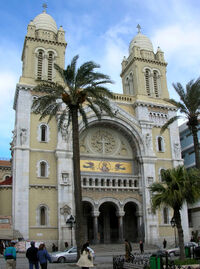
Patriarchal Cathedral of Mor Origen
The Apostolic Church of the Isles is the major denomination of Hosianism within Cildania and the dominant religion of the nation both in presence, demographics and its role in Cildanian history and nationalism. The Church of the Isles was created in 3981 as the merger of the Apostolic Department of Cildania and the Badaran Apostolic Church. The Church is an autocephalous (independent) Eastern Hosian Church based in Cildania, with members spread throughout the world. Eastern-rite Hosianism came to the island from nearby Kathuristan in Barmenia and quickly established itself. The Church of the Isles uses Kathuran as its official and liturgical language, but in practice the vernacular languages (Gziri, Majatran, Selucian, Qildari, Hebilean) are far more frequently used. The church is led by the Patriarch of Qart Qildar.
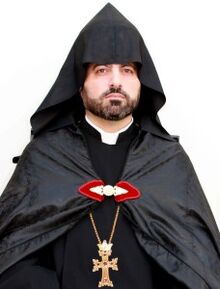
Patriarch David VIII
The Synod of Qart Qildar that created the Church of the Isles also granted its Patriarch the primacy of honor in the Eastern Hosian Communion, recognizing its increasingly central role in Apostolic affairs. For most of its earlier history however, the Department of Cildania was very inward-looking and on domestic and internal Departmental policy was entirely autonomous and differed significantly in a great number of points from the other Apostolic Churches, although it used to see itself as the superior church. The Church of the Isles is traditionally on the more conservative wing of the Eastern Rite and is Unitarian and Patriotic and, in Cildania, it retains much from the pre-Hosian Hebilean mythology and Proto-Qedarite Polytheism as well as a long record of divergence from the 'lesser branches' of the Eastern Rite, usually stemming from Cildanian exceptionalism. In time, especially after the recognition of Cildania's central role in the Apostolic Church of the East, these differences have lessened to some extent, although the Church of the Isles diverges somewhat from the liturgical practices of the Barmenian Apostolic Church, the other Western Kathuran Eastern Church, by the incorporation of Selucian elements and far greater use of the vernacular languages.
Yeudism[]
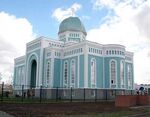
Yeudish Synagoque in Qart Qildar
Yeudism has always had a major presence in Cildania, the birthplace of its founder. This is also due to the fact that Cildania has traditionally been very open and accepting of the Yeudish people provided they put their Yeudish identity secondary to their Cildanian identity. To this day, the Cildanian Yeudi community remains an integral part of Cildanian culture, and the Yeudish minority consist of around 20% of the population.
Ahmadism[]
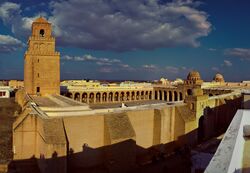
The Great Mosque of Ramesh, one of the oldest still standing mosques in Majatra
The presence of Ahmadism in Cildania dates to the early years of the religion. When Ahmadism was founded in Barmenistan, many Ahmadis faced persecution for their faith, several of whom finding refuge in the Cildanian principalities. Later on, the Ahmadi population in Cildania grew as a result of trade, as well as the presence of a large number of Majatran slaves. Following the Cildanian Civil War many more Ahmadis settled in Cildania, especially those fleeing the conflicts and massacres in neighboring Badara. The Ahmadi community in Cildania is distinguished by its relatively liberal nature, and most Ahmadis are fairly secular. A majority of Ahmadis in Cildania belong to the Israist school, and in Cildania the religion is closely connected to the Majatran ethnicity, although there are also numerous Hebilean and Qildari Ahmadis.
Irreligion[]
Non-believers have always retained a sizable minority within Cildania, often being the second largest religious group after Departmental Hosianism. Historically this his been accredited to the political dominance of the Department, especially in Akinawa and Hebilon and to the close ties between the Department and right wing nationalism in Cildania although in recent centuries foreign influences and secularism have taken the brunt of the blame.
Culture[]
The basis of Cildanian culture is formed by the mixing of cultures of the Ancient Hebilean tribes and the city-states of the Qedarites, as influenced by centuries of Cildanian history and most significantly, the Apostolic Department of Cildania. It also includes significant influences from continental Majatran and Selucian cultures, along with those of recent immigrants. Important festivals include Saint Sebastian's Day, First Sunrise and Divine Kingdom Day. More esoteric and exotic celebrations are held in several of the larger centres and the cantons retain strong traditions from before unification. The music and cuisine of Cildania are similar to that of other nations in Majatra, although both have some distinct Cildanian qualities.
The Cildanian media was historically dominated by the Circle Corporation which held a virtual monopoly over Television and Radio media as well as owning the majority of the Tabloids, for many years. A notable exception were the The Morning Sunrise newspaper, and Cilavision TV.
| Nations of Majatra | |
|
| |

